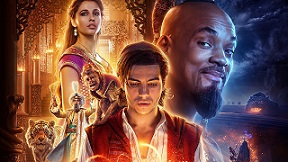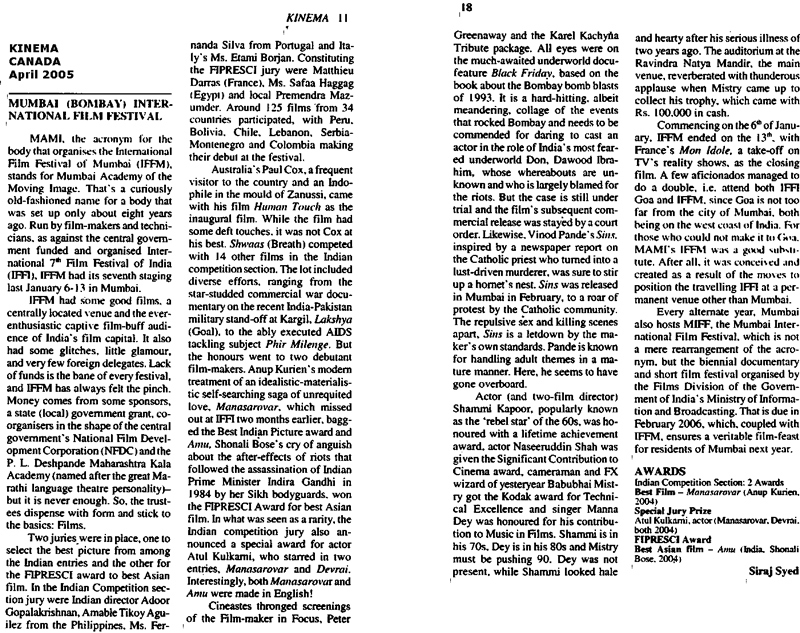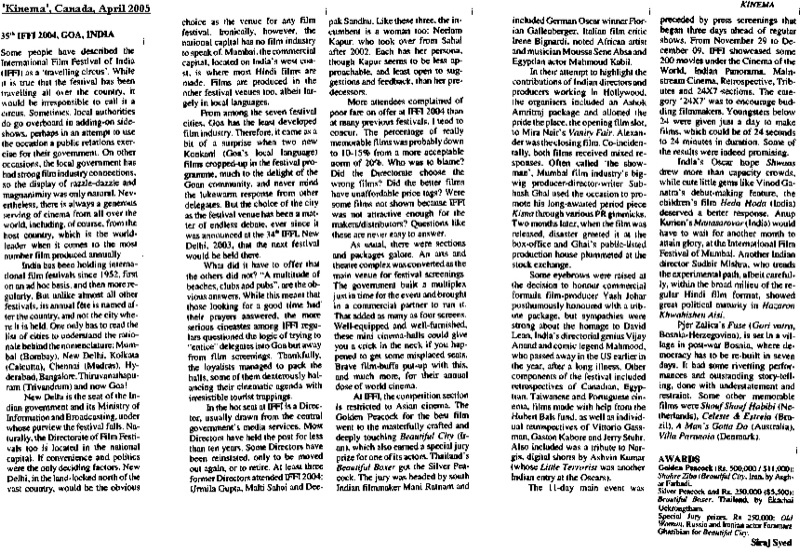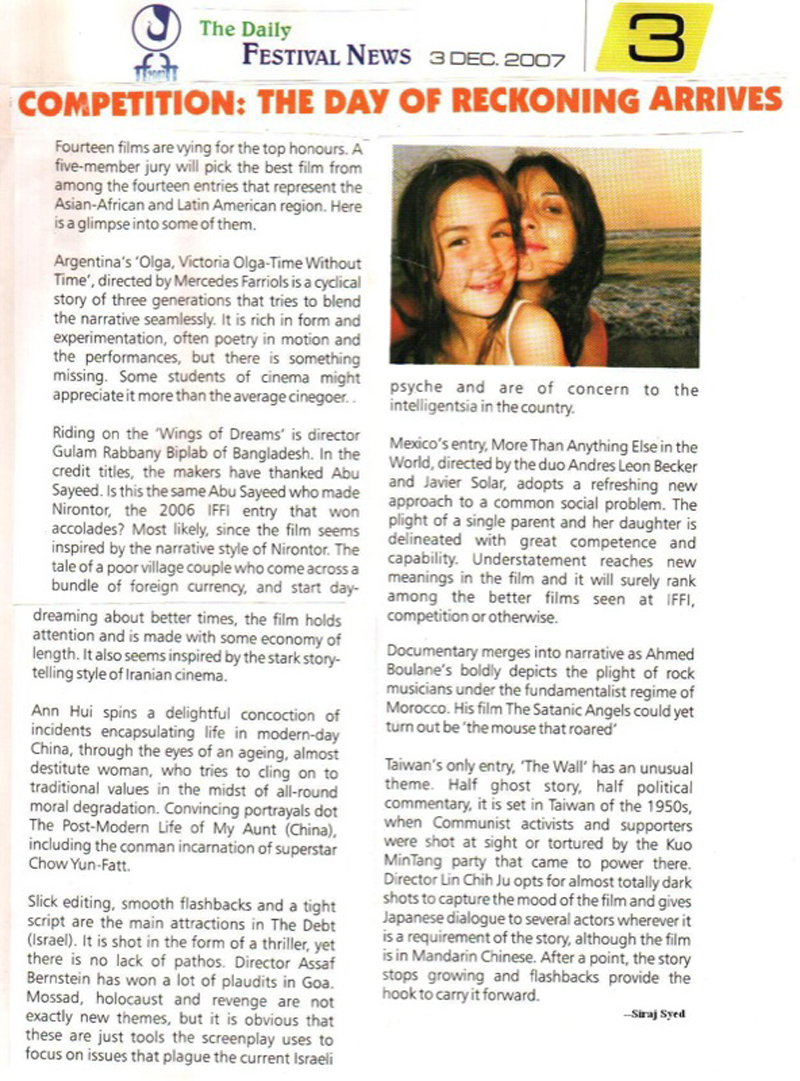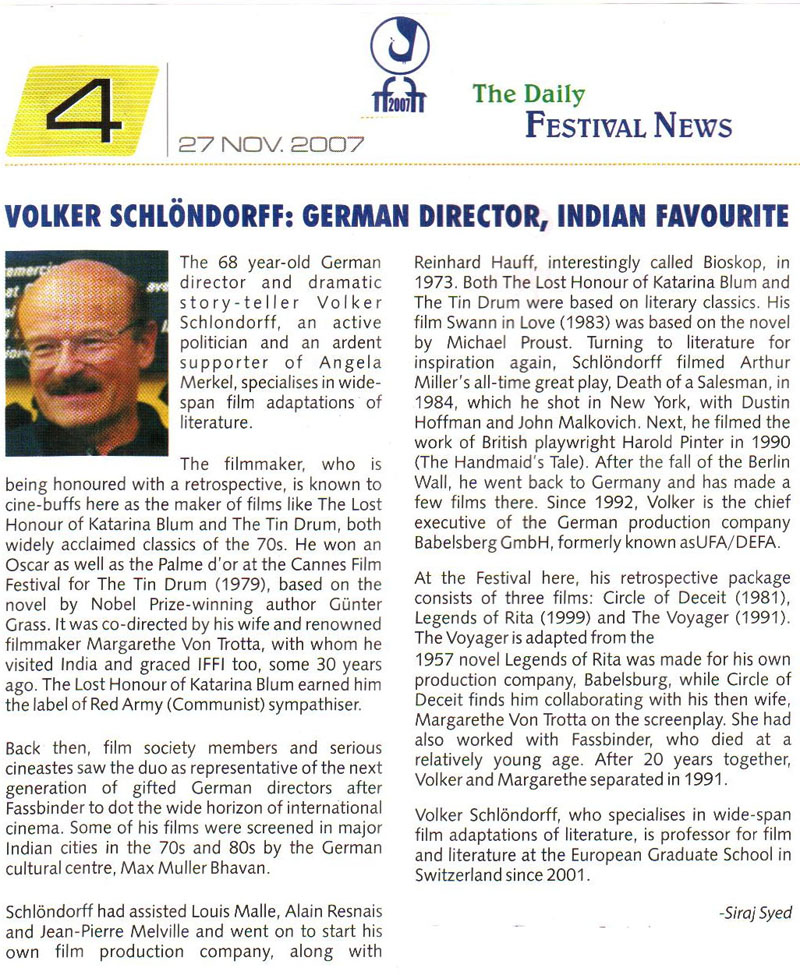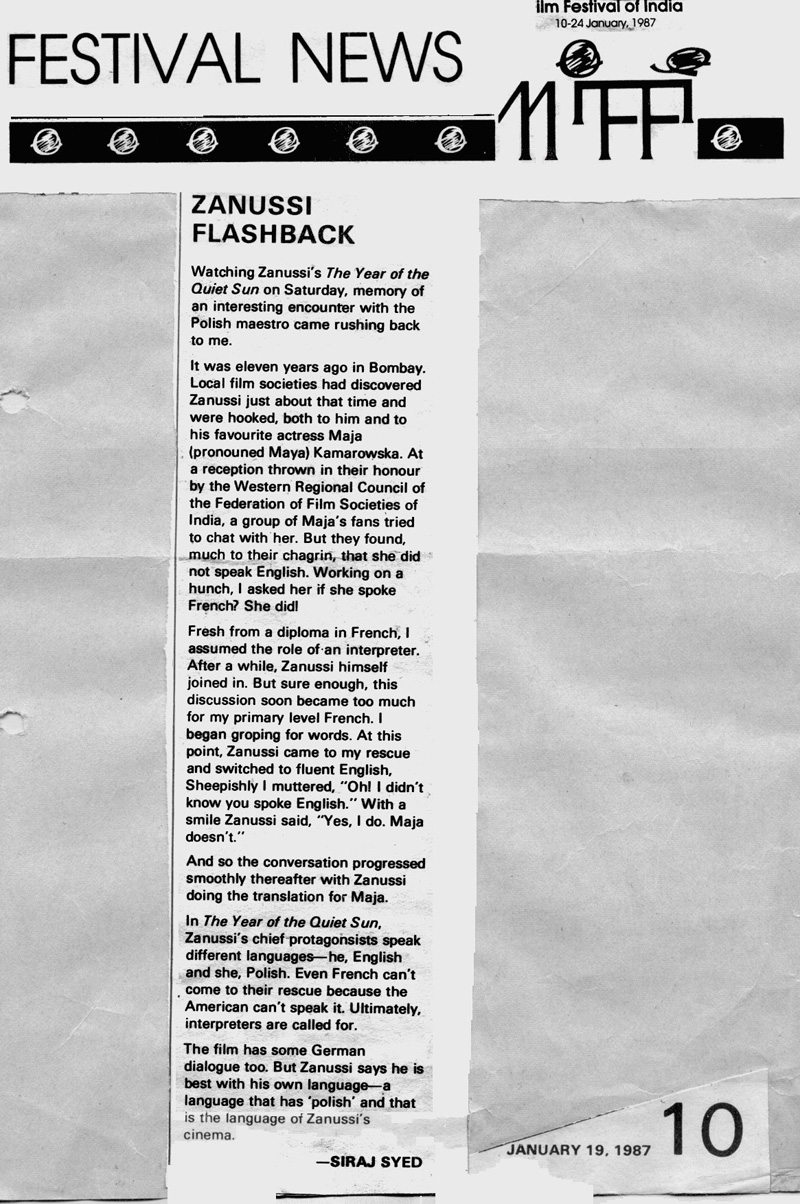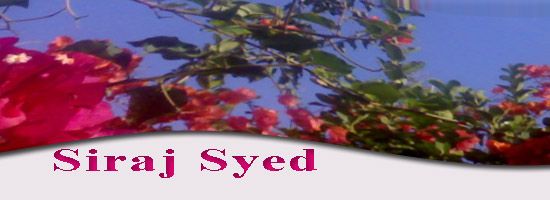|
|
||
|
Pro Tools
FILMFESTIVALS | 24/7 world wide coverageWelcome ! Enjoy the best of both worlds: Film & Festival News, exploring the best of the film festivals community. Launched in 1995, relentlessly connecting films to festivals, documenting and promoting festivals worldwide. Sorry for the interruption, we needed to correct and upgrade some modules. Working on a new website. For collaboration, editorial contributions, or publicity, please send us an email here. You need for put your full detail information if you want to be considered seriously. Thanks for understanding. User login |
Siraj SyedSiraj Syed is the India Correspondent for FilmFestivals.com and a member of FIPRESCI, the International Federation of Film Critics. He is a Film Festival Correspondent since 1976, Film-critic since 1969 and a Feature-writer since 1970. He is also an acting and dialogue coach. @SirajHSyed  Aladdin, Review: Aladdindeed
Aladdin, Review: Aladdindeed Believe it or not, Aladdin is a one-in-a-thousand-and-one story, part of The Thousand and One Nights (also called The Arabian Nights), stories narrated by a queen called Scheherazade, at bedtime, without revealing the end, to save herself from being killed by her husband, the murderous sadist who kills all his wives the day after he marries each one of them. Disney made an animated version in 1992, and here comes their live action CGI, musical avatar, directed and co-written by Guy Ritchie. It has its moments and might just be worthy of a visit to the nearest 3D, IMAX 6-Track/12-Track, DTS, Dolby Digital/Dolby Atmos/Dolby Surround 7.1 cinema hall. Aladdin, which should probably be spelt Allah Deen or Alauddin in original Arabic/Persian, is a street urchin, an orphan-thief in his lot, but a ‘Diamond in the Rough’ in his genes. He lives in the desert kingdom of Agrabah, along with his pet monkey, Abu, and sells stolen items for a pittance to a woman ‘receiver,’ to make a living. One day, a woman picks up some bread from a bakery shop and gives it to hungry beggars, but the owner accuses her of theft and demands that he be reimbursed. She has no money, so the keeper gets rough. Aladdin happens to be around, notices what is happening and rescues the woman, dodging his nemesis across alleys and tops of buildings. When they have gotten rid of their pursuers, he figures, from her attire and demeanour, that the woman must most likely be the hand-maiden of the Princess Jasmine of Agrabah. Whoever, she might be, he is truly smitten by her. Next day, when he enters the palace, hoodwinking the guards, he discovers that the woman he had met and fallen madly in love with is not the hand-maiden but the Princess herself, who first play-acts as the maiden, named Dalia, but soon reveals herself as Jasmine. Stunningly beautiful, Princess Jasmine is very upset that she is not allowed to step out of the palace (which is why she had snuck out the previous day, without anything on her, save her clothes) and the law of her kingdom, that requires her to marry a prince, only a prince, and not any other man she might fall in love with. Meanwhile, the King’s second-in-command, a rogue and a sorcerer called Jafar (Jaafar), the Royal Vizier (that should be vazeer, meaning minister), grows tired of being "second best". He and his parrot Iago thus seek a magic lamp (jadui chiraagh in Urdu) hidden within the Cave of Wonders, to become Sultan (Soltaan, to be accurate). Only one person is worthy of entering: "the diamond in the rough", whom Jafar later identifies as Aladdin. And the one who possesses the lamp will be able to summon a genie (jin), who will grant any three wishes of his master…any wish, except those involving death and man-woman love matters. This compendium of stories has been traced back to the 10th century. Its origins have been found in North African, Arabic, Turkish, Persian, Indian, and East Asian cultures. In 947, Arab historian Al-Masudi, for example, describes a large collection of a thousand (not 1001?) tales from all over the ancient world that he calls the Persian Hazar Afsaneh (A Thousand Stories). In Sir Richard Burton’s popular 1885 English translation, Aladdin lives “in a city of the cities, in China,” and not Agrabah, as in the Disney versions. Illustrations of the tales from the Victorian era depict the story and its characters as Chinese. The setting and the characters’ ethnicity begins to shift west to Arabia and the Middle East when the story is told on the big screen, in the early 20th century. And the index also lists other tales of similar formatting, Sindbad the Sailor and Ali Baba and the Forty Thieves. All three have been made in Urdu, in India, in the 20th century, many times over. Guess not having to pay royalty could be one factor, and the everlasting appeal to teenagers another. The best part is that most audiences know the chronicles by heart, and yet enjoy watching them on the big screen, with ever-improving technology. Moreover, huge liberties are taken in the recent versions, in a desperate attempt to add novelty as well. Aladdin was shot at Longcross Studios in Surrey, England, and the splendorous Wadi-e-Rum desert in Jordan. The film also pays tribute to the late Robin Williams, who voiced Genie in the 1992 animated feature. American writer John August (Charlie's Angels, Big Fish, Charlie and the Chocolate Factory) and Guy Ritchie (Sherlock Holmes, The Man from U.N.C.L.E., King Arthur: Legend of the Sword) have had great experience working with literary, legendary characters. I might mention that a script doctor names Vanessa Taylor also treated the script. They begin the tale with a couple and their son in a boat, definitely not in the 10th century, but much, much later, and the Aladdin story is narrated by the character of the father, played by Will Smith. Whatever happened to our own witty Queen Scheherazade (Shaherzaadee)? There is a slight adult-ish approach to the subject, with at least one scene of torture, using Jafar’s magic evil staff, shaped like a cobra. Director Ritchie lets Alan Menken’s songs come on gently, almost unsuspectingly, and then lets the song pick up along the way. Words are not too poetic, often what we call in India ‘tukbandee’(rhyme dominating, not high sentiments or poetic benchmarks). Fantasy means reality meets CGI, VFX and SFX, and Industrial Light & Magic have done a superb job of blending the two atoms into a perfect molecule. Endless chases, flights of carpetbaggers on flights fantasy astride a magic carpet, top angle views of the breath-taking old world charm that all of us dream of visiting via a time machine are other attractions that draw you into the world of make-believe. One character that has not been properly developed is that of the Sultan, while another character, Prince Anders of Skånland, is Ritchie humour at its best. Genial Will Smith was among the first to be cast, and he is the star. In fact, the film has less of Aladdin and more of Jasmine and the genie. His comedic touches add value, like when Aladdin tells him to get rid of his banded lock of hair (we call it chotee in India) which is all he has, dangling backwards, he says, “That’s my cherry”. Aladdin asks him for a favour, saying that he had himself said that Aladdin was the best friend he could ever have. Smith retorts, “That’s not what I said. I said I am the best friend you could ever have!” Mena Massoud (Christian, Egyptian-Canadian) as Aladdin is a bit of a disappointment, with a plain face and not-so-well-written role. Naomi Scott (Ugandan-Indian~I knew it) as Princess Jasmine raises a valid question: why could they not cast an Arab or other Middle Eastern actress? And guess what? Tara Sutaria of Student of the Year 2 (fame?) was also in the running at the early stages. Nevertheless, Scott is beautiful and humane at the same time, and fits into her designer costumes so well. Marwan Kenzari (Dutch, works in English too) is aptly cast as the nefarious Jafar, though the persona is rather uni-dimensional, making you wonder how was he appointed the Grand Vizier in the first place. Navid Negahban, the surname is a sure giveaway, is of Iranian parentage and now lives in America. He acts as The Sultan, a small role that needed to be expanded and probed. Nasim Pedrad, better known as a comedienne, is Dalia. She looks gorgeous, though her affection for the genie is irrational. Billy Magnussen, who has worked in American television, on stage and in films, gets a chance to add some humour as the slightly demented but wholly courteous Prince Anders. Alan Tudyk voices Iago, Jafar's sardonic scarlet macaw. Frank Welker reprises his voice roles from the original film as Abu, Aladdin's pet capuchin monkey, with a falsetto voice, and Rajah, Jasmine's protective pet Bengal tiger and best friend, who communicates through growling, roaring and grunting, as well as the sand guardian that resembles a form of a giant head of a tiger, who has been tasked to protect the magic lamp from intruders and give it to those who are worthy like a “diamond in the rough”. Come to think of it, Aladdin 2019 is a bit of a diamond in the rough. It needed more cutting and polishing, to sparkle like a solitaire. But then, though it may not be a solitaire, a diamond is still a diamond, and worth a look indeed. Rating: ** ½ Trailer: https://www.youtube.com/watch?v=JcMtWwiyzpU 24.05.2019 | Siraj Syed's blog Cat. : 1001 Nights 12-Track 3D Alan Menken Alan Tudyk Alibaba Arabian Nights Billy Magnussen Disney Dolby Atmos Dolby Digital Dolby Surround 7.1 DTS Frank Welker Guy Ritchie IMAX 6-Track John August Marwan Kenzari Mena Massoud Naomi Scott Nasim Pedrad Robin Williams Schehrezade Sindbad Tara Sutaria Vanessa Taylor will smith Hollywood FILM
|
LinksThe Bulletin Board > The Bulletin Board Blog Following News Interview with EFM (Berlin) Director
Interview with IFTA Chairman (AFM)
Interview with Cannes Marche du Film Director
Filmfestivals.com dailies live coverage from > Live from India
Useful links for the indies: > Big files transfer
+ SUBSCRIBE to the weekly Newsletter DealsUser imagesAbout Siraj Syed Syed Siraj Syed Siraj (Siraj Associates) Siraj Syed is a film-critic since 1970 and a Former President of the Freelance Film Journalists' Combine of India.He is the India Correspondent of FilmFestivals.com and a member of FIPRESCI, the international Federation of Film Critics, Munich, GermanySiraj Syed has contributed over 1,015 articles on cinema, international film festivals, conventions, exhibitions, etc., most recently, at IFFI (Goa), MIFF (Mumbai), MFF/MAMI (Mumbai) and CommunicAsia (Singapore). He often edits film festival daily bulletins.He is also an actor and a dubbing artiste. Further, he has been teaching media, acting and dubbing at over 30 institutes in India and Singapore, since 1984.View my profile Send me a message The Editor |

















